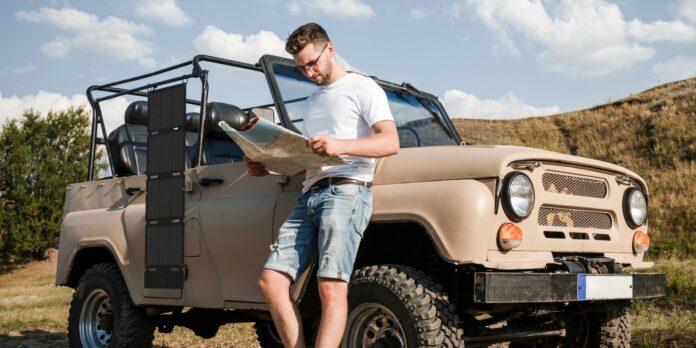Table of Contents
We’re all looking for greener technology, so naturally, we turn to solar power. It’s clean, green, carbon-free, renewable, and limitless as long as the sun shines.
Off-road enthusiasts, in particular, are eager to see if solar energy can meet the demands of rugged terrains. Wouldn’t it be great to explore the great outdoors using only clean energy from the sun?
This article will explore the challenges and innovations shaping this emerging field and answer the question: can solar power drive the future of 4WD vehicles?
Is There Such a Thing as a Solar-Powered Car?
Solar-powered cars aren’t just science fiction; they are out there. However, this brand-new technology is still being developed, so it’s not yet available in retail markets.
Is There a 4WD Car Powered by Solar Panels?
Yes, there are also 4WD cars powered by solar panels, also called photovoltaics. In 2023, the world’s first off-road SUV successfully finished a 1,000km (620 miles) test drive across North Africa.
The Challenges of Solar-Powered Cars
Let’s explore some of the challenges to overcome before solar-powered cars become widely available.
Surface Area
Sunshine gets scattered as it travels through our atmosphere, so it’s most efficient when directly overhead. It changes throughout the seasons, so on average, we get about 342 Watts per square meter.
A full-size car has only about 9-10 square meters of horizontal surface, and an electric vehicle (EV) currently requires about 20,000 Watts to drive 100 km/h (60 mph). Thus, it is impossible to collect enough energy to consistently power a car of average size and weight.
Research models now being tested are ultra-light with little room for anything but the driver.
Lack of Efficiency
While technology has improved dramatically, photovoltaic efficiency is still too low for the surface area available. Our best widely available photovoltaic panels, like EcoFlow’s Solar Panels, have a 23% conversion efficiency. Most other panels are between 6% and 20% efficient, depending on the technology. Other technologies are up to 30% efficient, but the cost is still so high that they are only used on satellites.
Limited Range
Due to low efficiency and limited surface area, solar-powered cars have a limited range. Those still in their testing phase can go farther because they are made ultra-light and have little room for anything but a driver.
Driving at Night
Another problem is that people need to drive at night. Batteries solve that issue. However, adding weight significantly reduces their range. We need to improve the energy density of our batteries before these cars can drive at night.
Weather Dependency
Weather is always a challenge. Photovoltaics don’t produce much energy when it’s cloudy or rainy. When you factor in the seasonality of most places on Earth, any car without significant battery backup will struggle to produce enough power to run in winter or bad weather.
Not Available Yet in Retail Market
Since these vehicles are still in the testing phase, it will be some time yet before they are available in the retail market.
However, eco-conscious people with EVs have plenty of options available now. For instance, you can use EcoFlow 400W Rigid Solar Panels on your home or carport. If you combine that with batteries, you can charge your EV with solar anytime it’s parked at home.
You can bring EcoFlow Portable Solar Panels on a road trip to top up your charge. The EcoFlow 220W Bifacial Portable Solar Panel is a great portable option with an impressive up to 25% conversion rate. While it won’t give you a full charge fast, it can top you up and get you to the next charging station.
We also have options like using a solar generator to run your appliances in your motorhome. You can even mount flexible photovoltaics to the roof. The EcoFlow 100W Flexible Solar Panel is easy to attach to any motorhome or even a car roof with enough space. Flexible panels produce less energy than rigid panels, but they are still a good supplement to your power supply.
Final Thoughts
Using solar power to run your car is no longer science fiction. The technology is out there but still being developed, so it has yet to be available in the retail market. In the meantime, you can use EcoFlow Solar Panels to charge your EV and power appliances in your motorhome. Also, consider installing EcoFlow Flexible photovoltaics on your motorhome’s or other vehicle’s roof to supplement your power supply.
Finally, bring a portable photovoltaic panel with you to supplement your charge or give you a top-up while you are parked on a road trip. This gives you plenty of great options to benefit from clean, free energy from the sun while we wait for the technologies to improve enough to hit the retail markets.


